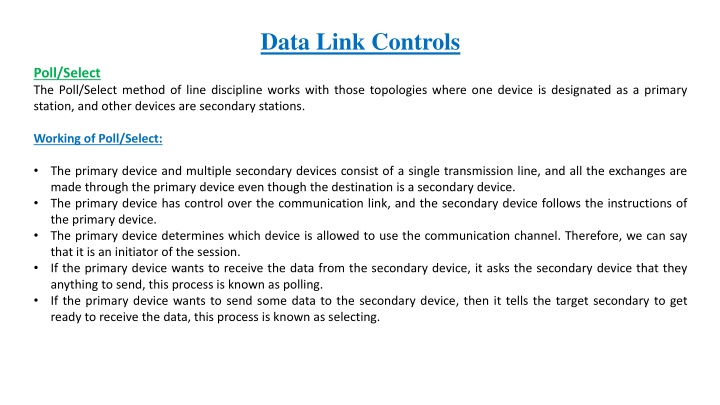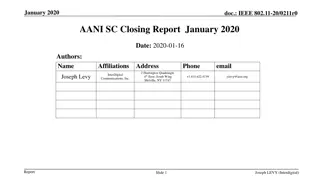
Understanding Data Link Controls: Poll and Select Methods for Line Discipline
Explore the Poll/Select method of line discipline in networking, where a primary device controls communication with secondary devices. Learn how polling and selecting are used for data transmission, along with practical examples.
Download Presentation

Please find below an Image/Link to download the presentation.
The content on the website is provided AS IS for your information and personal use only. It may not be sold, licensed, or shared on other websites without obtaining consent from the author. If you encounter any issues during the download, it is possible that the publisher has removed the file from their server.
You are allowed to download the files provided on this website for personal or commercial use, subject to the condition that they are used lawfully. All files are the property of their respective owners.
The content on the website is provided AS IS for your information and personal use only. It may not be sold, licensed, or shared on other websites without obtaining consent from the author.
E N D
Presentation Transcript
Data Link Controls Poll/Select The Poll/Select method of line discipline works with those topologies where one device is designated as a primary station, and other devices are secondary stations. Working of Poll/Select: The primary device and multiple secondary devices consist of a single transmission line, and all the exchanges are made through the primary device even though the destination is a secondary device. The primary device has control over the communication link, and the secondary device follows the instructions of the primary device. The primary device determines which device is allowed to use the communication channel. Therefore, we can say that it is an initiator of the session. If the primary device wants to receive the data from the secondary device, it asks the secondary device that they anything to send, this process is known as polling. If the primary device wants to send some data to the secondary device, then it tells the target secondary to get ready to receive the data, this process is known as selecting.
Select The select mode is used when the primary device has something to send. When the primary device wants to send some data, then it alerts the secondary device for the upcoming transmission by transmitting a Select (SEL) frame, one field of the frame includes the address of the intended secondary device. When the secondary device receives the SEL frame, it sends an acknowledgement that indicates the secondary ready status. If the secondary device is ready to accept the data, then the primary device sends two or more data frames to the intended secondary device. Once the data has been transmitted, the secondary sends an acknowledgement specifies that the data has been received.
Poll The Poll mode is used when the primary device wants to receive some data from the secondary device. When a primary device wants to receive the data, then it asks each device whether it has anything to send. Firstly, the primary asks (poll) the first secondary device, if it responds with the NACK (Negative Acknowledgement) means that it has nothing to send. Now, it approaches the second secondary device, it responds with the ACK means that it has the data to send. The secondary device can send more than one frame one after another or sometimes it may be required to send ACK before sending each one, depending on the type of the protocol being used.
H.W. 2 An Information system consists of one mainframe pc. as a primary and four secondaries A, B, & C, consider if the mainframe fetched a frame of data from Pc.(B), and pc.(C) with separate and individual fetching trip, then encapsulated them in one frame and sent it to a pc.(A). Due to linediscipline concepts, explain in figures the procedure of fetching & transmitting of these frames, if there is no direct transmission of signals between them.



















